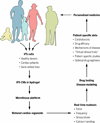Distilling complexity to advance cardiac tissue engineering
- PMID: 27280684
- PMCID: PMC4959426
- DOI: 10.1126/scitranslmed.aad2304
Distilling complexity to advance cardiac tissue engineering
Abstract
The promise of cardiac tissue engineering is in the ability to recapitulate in vitro the functional aspects of a healthy heart and disease pathology as well as to design replacement muscle for clinical therapy. Parts of this promise have been realized; others have not. In a meeting of scientists in this field, five central challenges or "big questions" were articulated that, if addressed, could substantially advance the current state of the art in modeling heart disease and realizing heart repair.
Copyright © 2016, American Association for the Advancement of Science.
Figures



References
-
- Menasche P, Vanneaux V, Hagege A, Bel A, Cholley B, Cacciapuoti I, Parouchev A, Benhamouda N, Tachdjian G, Tosca L, Trouvin JH, Fabreguettes JR, Bellamy V, Guillemain R, Suberbielle Boissel C, Tartour E, Desnos M, Larghero J. Human embryonic stem cell-derived cardiac progenitors for severe heart failure treatment: first clinical case report. Eur Heart J. 2015;36:2011–2017. - PubMed
-
- Bhatia SN, Ingber DE. Microfluidic organs-on-chips. Nat Biotechnol. 2014;32:760–772. - PubMed
Publication types
MeSH terms
Grants and funding
LinkOut - more resources
Full Text Sources
Other Literature Sources

